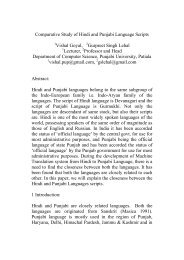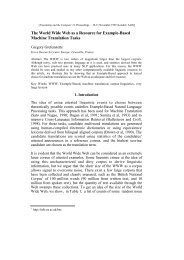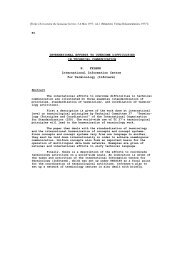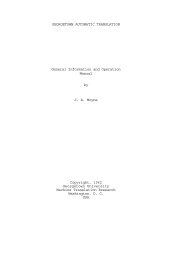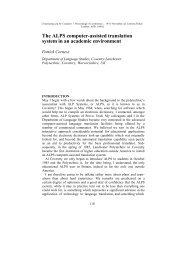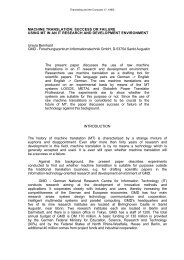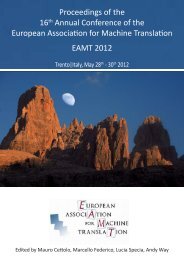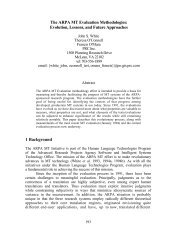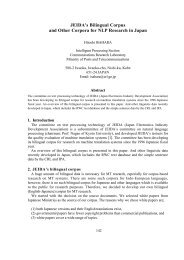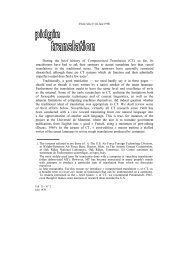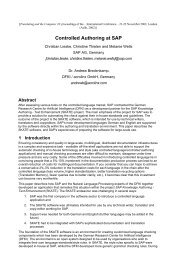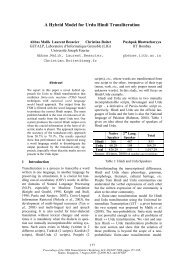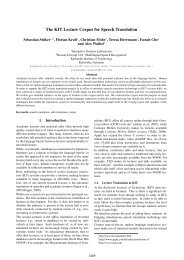MT News International no.18 - Machine Translation Archive
MT News International no.18 - Machine Translation Archive
MT News International no.18 - Machine Translation Archive
Create successful ePaper yourself
Turn your PDF publications into a flip-book with our unique Google optimized e-Paper software.
context, a problem which is exacerbated in a language-pair such as Korean--English.<br />
Their approach is to apply a statistical model of dialogue structure based on trigrams of<br />
speech acts. Keiko Horiguchi discussed meaningful ``errors'' in speech which convey<br />
contextual meaning or the speaker's attitude, and then focused on the translation of<br />
discourse particles from Japanese into English. The approach adopted here is an<br />
analogical framework using a Cascaded Noisy Channel Model.<br />
Dealing with Differences<br />
The three presentations in this section explored some aspects of the SLT problem,<br />
which highlight the differences between translation of written and spoken text. Yumi<br />
Wakita described a method, which attempts to extract the parts of a spoken utterance,<br />
which have been reliably recognized, ignoring those which represent probable<br />
recognition errors. They presented results indicating that their method has an appreciable<br />
effect on the performance of a Japanese-English speech translation system.<br />
Keiko Horiguchi and Alexander Franz described another piece of work aimed at<br />
counteracting the problems involved in taking translation input from a speech recognizer.<br />
They presented an example-based hybrid approach containing aspects of both corpusbased<br />
and rule-based styles of translation architecture; this move towards hybrid<br />
architectures seems to represent a strong tendency in current work within the field of<br />
SLT.<br />
Finally, Pascale Fung presented a paper focussed on the problems which a speech<br />
recognizer has to contend with in a multilingual environment, where people typically<br />
speak using a variety of languages and accents. The talk described initial experiments<br />
which investigate the parameters of the problem, and in particular explored the possibility<br />
of constructing recognizers capable of recognizing multilingual input.<br />
Towards Efficiency<br />
The papers in this section addressed problems of efficiency in two senses. On the<br />
one hand SLT has to meet specific requirements of efficiency and robustness in<br />
processing, because speech recognition is imperfect, spoken utterances are often<br />
linguistically not well-formed, the translation must be available nearly simultaneously<br />
with the utterance, the quality of the translation must be sufficiently high as in most<br />
applications post-editing is not possible.<br />
To solve these problems finite state transducer technologies are often employed<br />
and investigated. The papers by Alshawi and Amengual discussed different approaches<br />
along these lines. Both attempt to gain additional efficiency by a tight integration of<br />
analysis and transfer instead of assuming two different processing stages.<br />
Another efficiency problem is that of acquiring the knowledge for building such a<br />
system. SLT systems are often heavily restricted to specific domains and in their<br />
vocabulary. This raises the question how such systems can be adapted to new domains<br />
and vocabulary. Therefore corpus-based statistical methods for language modelling and<br />
automatic acquisition are of special interest for SLT as addressed by Amengual and<br />
Frederking.<br />
Methodological Issues<br />
The common theme for the final three papers in the workshop was an emphasis on<br />
methodology and architecture. The first paper in the section, by Lavie, focused on the<br />
issues that arise when one transfers from a relatively narrow domain (in this case,



